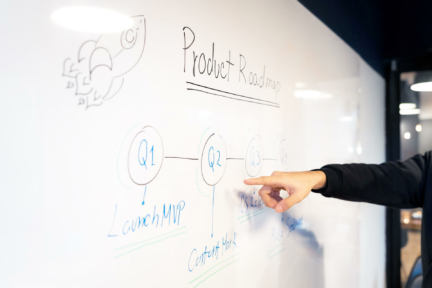The majority of great ideas never make it to the market. And among those that do, only a small percentage survive long. What makes them fail? When searching for reasons, we intuitively lean towards the lack of market research and user testing. But often, the issue lies elsewhere – in the choice of inappropriate technology, unsustainable software architecture, or insufficient resources for the product development process. Unsuccessful implementations often share a common factor—their basic assumptions were not tested in practice and adjusted based on findings.
It’s better to prevent than to cure, and that’s precisely the purpose of a Proof of Concept. Sometimes confused with an MVP or prototype, it is a separate tool that allows you to view the product from a realistic perspective before thousands of euros and resources are invested. However, unlike an MVP, PoC does not focus on market needs but strictly on technical feasibility. Thanks to our software development experience, we know it’s better to address potential issues early on. How to handle Proof of Concept development right? Our article breaks down PoC and its preparation, leaving you with practical tips to use on your own or with a team.
What is a Proof of Concept?
Proof of Concept, also known as PoC, is the evidence gathered from an initial pilot project that is used to demonstrate that a theoretical project idea is achievable. PoCs are frequently employed by project managers in various industries to test innovative solutions and determine their viability. These concept examples are crucial for validating new product developments, business strategies, and more.
Why is Proof of Concept important?
Imagine ordering a custom-made suit for an important event. Before the tailor begins full production, you have several fittings to ensure everything goes according to plan and that the suit can be delivered on time and within budget.
Similarly, PoC in a project helps verify whether the product can be technically executed within the available resources.
- Material and budget: During fittings, you determine if the fabric for the suit is suitable and if the cost fits your budget. In PoC, you assess whether the technology required for the product is available, whether the budget allows for its use, and if the project fits within financial constraints.
- Tailor and technical resources: You check if the tailor has the necessary skills and tools to craft the suit according to your specifications. PoC helps evaluate if the technical team and available infrastructure are sufficient to develop the product and if additional resources or tools are required.
- Timeline: Fittings help determine if the suit can be completed on time, especially if many adjustments are needed. In PoC, you verify whether the project can be completed within the projected timeline and if any time-consuming technical aspects will cause delays.
- Feasibility: Ultimately, by trying on the suit, you assess whether it’s worth investing in further adjustments and finishing touches. PoC checks if the project is financially and technically feasible—whether the execution will stay within budget and if the final product will deliver the expected benefits.
This technical “fitting” (PoC) confirms that the project is feasible, will not exceed the budget, and will be profitable before committing to full-scale development.
What does Proof of Concept verify?
Proof of Concept can verify whether your project is financially and technically viable, preventing you from wasting resources on projects that are not sustainable or unlikely to bring a return on investment. It identifies possible roadblocks, indicating potential directions for change in the further stages of the product development lifecycle. You can use the PoC process to test the whole project idea or validate a particular feature that you want to introduce at a later stage. However, it’s important to note that PoC focuses on technical feasibility, not market validation.
What does Proof of Concept serve for?
A Proof of Concept (PoC) aims to explore if a business idea is technically achievable and can be implemented. It helps outline how a product idea can be launched, function, and meet the necessary success criteria. While it doesn’t focus on market needs or competition at this stage, a successful PoC provides essential insights for guiding the technical direction of the project.
PoCs are crucial for:
- Prototyping
- MVP development
- Deciding on software systems and technical specifications.
Proof of Concept is a great tool to build trust among stakeholders and investors engaged in your application development. It can clear their doubts and fuel motivation to further invest their resources in the project. And if your next step involves pitching your validated idea to potential partners or investors, an email finder can be a useful tool for reaching the right people fast.
The fact that you are including Proof of Concept in your product journey already shows that you plan ahead, having potential obstacles and challenges in mind. By identifying technical challenges early, PoC can help you notice potential issues in advance and prepare accordingly, creating a protective shield for your project.
MVP vs PoC – What is the difference?
An MVP (Minimum Viable Product) tests the market viability of a product, while a PoC (Proof of Concept) verifies technical feasibility. The key difference lies in their purpose and stage in development:
- MVP: Focuses on creating a usable product with core features to gather feedback from real users. It takes months to develop, as it must be polished enough to be market-ready and deliver meaningful insights.
- PoC: Focuses on proving whether an idea or technology can be successfully implemented, often completed in just a few days. It demonstrates whether a concept is feasible but lacks the broader functionality of an MVP.
Ultimately, an MVP tests market demand, while a PoC checks if something is technically possible.
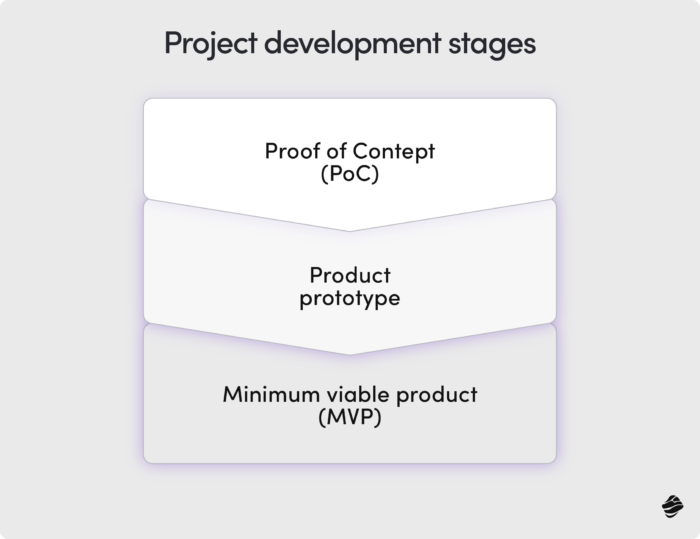
PoC vs Prototype – What is the difference?
A Prototype is an early model of a product used to visualize and test its design and functionality, while a PoC (Proof of Concept) verifies the technical feasibility of a specific idea or component. The key difference lies in their focus and level of completeness:
- Prototype: Aims to demonstrate how a product might look and function, focusing on user experience and interface design. It is a tangible representation of the product that allows stakeholders and potential users to interact with and provide feedback. Prototypes can take weeks or even months to develop.
- PoC: Focuses solely on testing whether a certain technology or idea can be executed successfully. It is typically a quick, small-scale test that verifies technical possibilities without building the full product.
Ultimately, a Prototype helps test and refine how a product will work in practice, while a PoC simply checks if a specific concept is technically achievable.
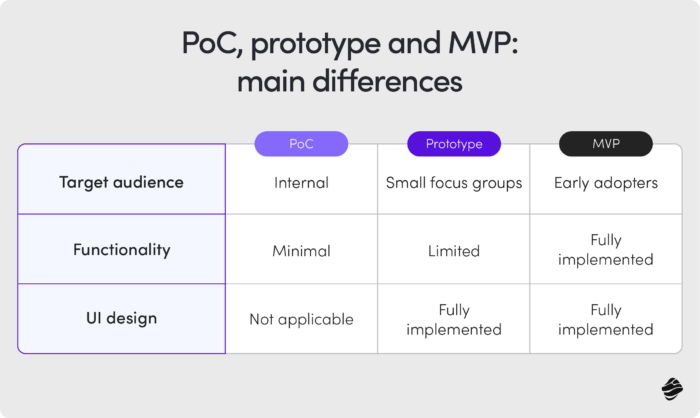
When should you create a PoC – is there a right moment?
If you’re in a rush, nothing good comes out. Your PoC should be created after you’ve fully developed and defined your idea, as it is the first step in the technical implementation of the concept.
If you’re still unsure about the problem you aim to resolve or the target audience, or if you’re wondering whether to go international or start locally, it’s too early for a PoC. These aspects influence technical feasibility, and performing a PoC too early could distort your view of the project and lead to poor decisions.
Why PoC is essential in software development projects?
A Proof of Concept (PoC) is crucial in the software development process because it allows for thorough validation of the concept. Creating a digital product is no easy task—it requires a significant investment of resources, including financial ones. A concept that hasn’t been tested poses a huge risk.
PoC in digital business development process
Imagine you’re trying to launch a new line of trendy shoes. These shoes feature soles with a specific design and materials you’ve never used before, requiring you to adapt your production line. You wouldn’t stock up on all necessary materials, hire designers, and invest in specific manufacturing elements without validating the idea.
The same applies to digital products. Let’s look at it through the lens of a practical example. You’re developing an app that generates personalized content for users with help of Generative AI. By completing a PoC, you will be able to clearly define potential roadblocks related to such integration, such as the accuracy of personalization and the impact on the app’s performance. You will define the necessary resources and choose the model that has the biggest chance of meeting your project’s success criteria.
Key benefits of a successful PoC
A Proof of Concept (PoC) plays a crucial role in validating the potential of a project before full development. It can also help you to estimate app development cost before embarking on the idea to ensure proper budgeting and planning.
Here is a list of key advantages that demonstrate how a successful PoC can enhance project outcomes and ensure long-term success.
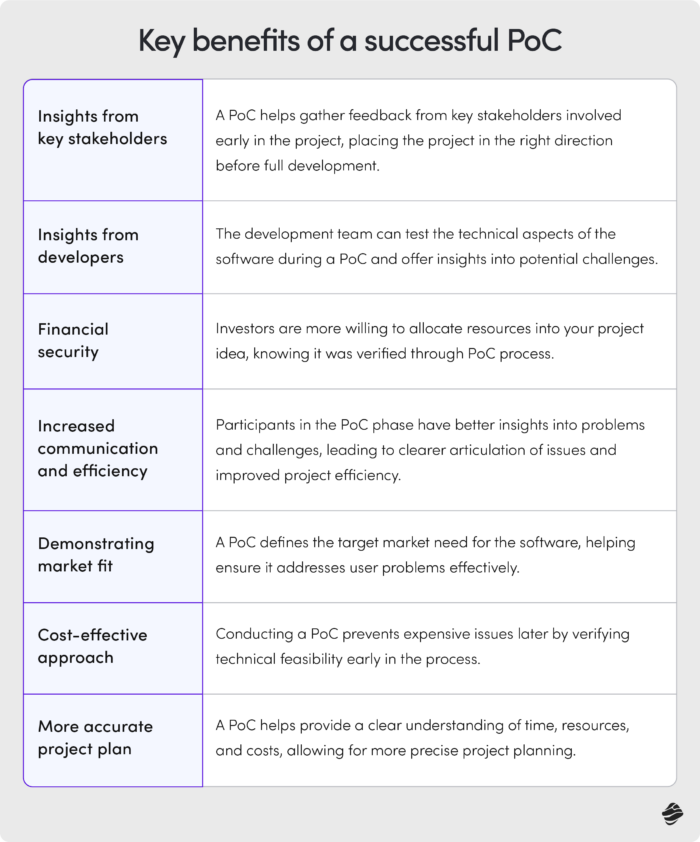
The Step-by-step process of creating a successful Proof of Concept
Whether you are testing a whole solution or a particular feature, the draft of your Proof of Concept should consist of a defined problem, target audience, necessary resources, success criteria, selected tech stack, project scope, and timeline. Having these elements outlined, you will be capable to test these assumptions in practice. Your concept is proven through analyzing the evidence gathered during the next phases. If you looked deep enough, you will identify obstacles that likely will occur at the later stages and prepare for them or correct your choices accordingly.
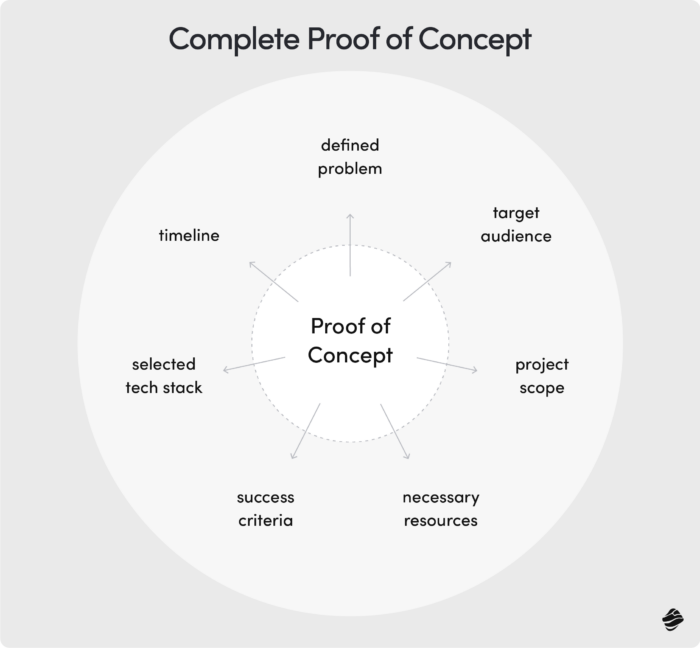
How does this process look in practice? Here’s the usual roadmap.
1. Define the problem
While an effective Proof of Concept (PoC) doesn’t assess how the market will receive your product, it should confirm that there’s a genuine market need. Start by clearly identifying the pain points your target audience faces and back it up with research. You could, for example, talk to a small representative group to gather insights. Look for patterns in their responses to help define the essential features your software should include.
2. Define the Solutions
Now, take the feedback you’ve gathered and start brainstorming solutions that address the identified pain points. Match these ideas to your product concept. Once you have a few solid solutions, go back to your research group and get their feedback to make sure you’re on the right track.
3. Deliver a Prototype
With the solutions in mind, build a prototype that includes the key software features. Test this prototype with your sample group to see if it truly addresses their needs. Make sure to document everything to show the product’s usability and technical feasibility.
4. Present the PoC
Bring together all key stakeholders and present your PoC along with a Product Roadmap. This should outline your research, how the product solves the audience’s problems, the main features, and the technology you’ll use.
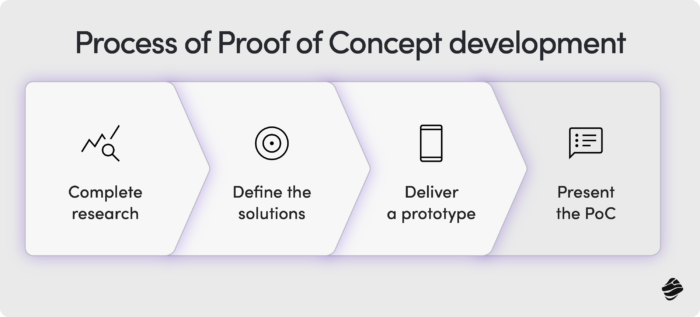
Common Challenges and Risks in POC Development
Well though-out PoC project is the best shield against technical challenges, but its development process can be challenging, too. Here’s what you should have in mind.
Scope creep
At the early stages of a project, everything seems possible. Trying to make the most of it, teams can easily cross the line and start adding features, often encouraged by key stakeholders. As a result, the scope expands, drifting away from the core idea. The technical challenges thus change, and the estimated feasibility of the project is no longer relevant.
Recommendation: Clearly define and enforce project boundaries to avoid unnecessary expansions during the PoC phase.
Lack of clear success criteria
Everyone has their own definition of success. If everyone involved in the project is supposed to stay on the same page, you should pay extra attention to establishing clear success criteria. Without predefined success metrics, it becomes difficult to assess whether the PoC has achieved its objectives.
Recommendation: Set clear, measurable success criteria from the outset to ensure consistent evaluation across all stakeholders.
Unrealistic expectations
Looking on the bright side can help your team move forward, but beware of excessive optimism. Know your enemy—understand the potential obstacles instead of pretending they don’t exist. The more conscious you are of these challenges, the better. Otherwise, your PoC may not deliver on its promises, potentially leading to project abandonment.
Recommendation: Align expectations with realistic goals by conducting a thorough risk assessment at the start.
Resistance to change
Sometimes radical changes in modus operandi are needed for your Proof of Concept to be feasible. It could involve switching to another framework that requires part of your team to expand their competencies or adopting a different project management model and teaming up with external specialists.
Recommendation: Engage and communicate with teams early to minimize resistance and prepare them for necessary changes.
Rushed development
Nothing good ever comes from rushing. Although at the early stages of development you operate on concepts and may not feel the weight of processes, this is when the cards are dealt. It’s crucial to take your time to evaluate the problem definition, resource allocation, technical choices, and their potential impact on the project’s success.
Recommendation: Allocate sufficient time for planning and validation to prevent rushed decisions that could undermine the PoC’s effectiveness.
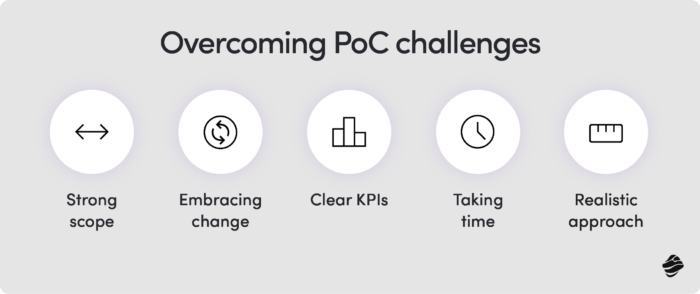
Case Studies of Successful POCs in Software Development
A PoC is developed by most companies that bring products to market. Serving as the foundation for prototypes and, later in the development process, MVPs, PoCs are a routine element of the software development cycle. However, as they are primarily intended for key stakeholders and investors, they rarely reach the public eye.
The furthest the general public typically gets into a company’s development process is the MVP stage. Nevertheless, some cases are made public, usually involving a new feature or integration.
Netflix’s content delivery optimization using open connect
Netflix developed its Open Connect Appliance (OCA) to optimize content delivery by directly interconnecting with internet service providers (ISPs). To validate this approach, they conducted a Proof of Concept (PoC) by testing the system in select geographies, aiming to reduce bandwidth costs, improve streaming quality, and lower buffering times. Partnering with ISPs in these regions, Netflix evaluated the system’s performance.
After the PoC successfully demonstrated enhanced content delivery and cost savings, Netflix scaled Open Connect globally, significantly reducing its reliance on third-party content delivery networks (CDNs). The initial concept behind the OCA is publicly available in the form of an extensive briefing. You can see how Netflix identified the issues and challenges and outlined a plan that proved successful here.
Pajo’s proof of concept delivered 40% faster
Another case study is Pajo, a platform designed to deliver omnichannel experiences in retail stores, hotels, and art galleries. Miquido delivered the Proof of Concept (PoC) in just 60% of the estimated time, allowing for faster validation of the platform’s core features. To ensure optimal performance and scalability across industries, the team decided to build Pajo using Flutter, a flexible cross-platform framework. The success of this PoC enabled the project to transition smoothly into full-scale development, offering tailored digital experiences for diverse sectors.
Ford’s autonomous vehicles in Miami
Autonomous vehicles are a dynamically developing niche with many market paths still to be paved. Market leaders deeply rooted in the traditional automotive industry are slowly embracing this shift, and well-thought-out PoCs help them protect their interests.
Ford provides a good example. The company began testing autonomous vehicle technology in Miami to understand the potential for self-driving cars in urban environments. They set up a controlled pilot program in specific areas of Miami, partnering with local businesses and city authorities to test the viability of using autonomous vehicles for deliveries and ride-sharing services.
After successful PoC trials, Ford committed to investing in full-scale autonomous vehicle development and expanded its autonomous vehicle division (Ford Autonomous Vehicles LLC), with plans to launch a commercial service.
Tools and technologies for PoC Development
To ensure a successful Proof of Concept, leveraging the right tools and technologies is essential for accurately defining problems and identifying potential roadblocks. These tools aid in visualizing issues, gathering user insights, and managing project risks, ultimately guiding the development process toward informed and efficient solutions.
Define the problem accurately:
- Miro: A collaborative whiteboarding tool that allows teams to map out problems visually. It supports brainstorming, user journey mapping, and issue prioritization.
- Lucidchart: A diagramming application that helps visualize processes, systems, and workflows to better understand problem areas and interdependencies.
- User Research Tools (e.g., Typeform, Google Forms): These tools can be used to conduct surveys and gather feedback directly from users, helping to pinpoint pain points and specific needs.
- ProtoPie is a good choice, especially for projects focused on user interaction and design. It allows teams to create high-fidelity interactive prototypes without coding, enabling them to test and validate the user experience early on. This makes it a valuable addition for gathering feedback on a product’s functionality and usability during the PoC phase.
- Trello: A project management tool that allows teams to break down complex problems into manageable tasks, track issues, and prioritize them effectively.
Identify roadblocks:
- Jira: A comprehensive project tracking tool that allows teams to identify bottlenecks, technical dependencies, and development roadblocks. It is especially effective for software teams working with agile methodologies.
- Asana: A project management tool that can be used to monitor progress, track tasks, and identify areas where potential obstacles might arise.
- Risk Register (MS Excel or Smartsheet): A straightforward way to catalog potential risks and roadblocks during the PoC process. It helps teams evaluate risks and determine how to mitigate them.
- GitHub Issues: For technical projects, GitHub’s issue tracking can be used to highlight potential technical challenges or dependencies that could delay development.
Gather extensive evidence:
- Google Analytics / Mixpanel: These analytics tools can help gather quantitative evidence by tracking user behavior and engagement, useful for validating PoC assumptions.
- Usability Testing Tools (e.g., UserTesting, Hotjar): These platforms gather user feedback and interaction data, providing critical insights into how users engage with a prototype or product feature.
- Data Visualization Tools (e.g., Tableau, Power BI): For presenting data and evidence to stakeholders, these tools provide clear and visual insights into metrics, KPIs, and overall PoC results.
- Slack or Microsoft Teams: Collaboration platforms that allow teams to share insights, gather feedback, and communicate findings in real-time with stakeholders.
When to Move from POC to Full-Scale Development?
Proof of Concept phase is a safe place, but at some point you need that leap of faith. When should you move on from PoC and dive deep into new waters? Here’s a checklist of questions to help guide your decision:
- Has the PoC proven the technical feasibility of your concept?
- Are the core functionalities working as expected in the PoC environment?
- Do you have stakeholder and investor confidence based on PoC results?
- Have you identified and mitigated key risks highlighted during the PoC?
- Is the development timeline realistic and aligned with the resources available?
- Does the budget accommodate the next phase of full development?
- Have you gathered enough feedback from developers and users to inform the next steps?
- Are you confident in the scalability of the solution beyond the PoC stage?
If you’ve answered “yes” to these questions, you’re ready to take the next step! However, figuring out the right moment might not be as ready as it seems. Our product strategy consultants can help you navigate this process with success.





